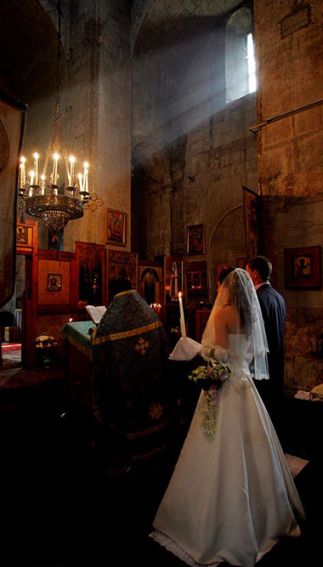Source: Orthodox Church of Estonia
1.- Love – Divine and Human. Preliminary remarks
Love, marriage, and sexuality concern everyone, because love is a vocation for everyone. As Christians, we believe that the entire creation was made through love. The source and end of all things is love, because the source and end of all things is God, and “God is love” (1 John 4 : 8, 16). St. John Chrysostom describes the all-embracing love of the incarnate God in a homily on the Gospel of Matthew :
“I am a father for you [says Christ) and a brother, a bridegroom and a home, a nurse and a dressing, a root and a cornerstone. Whatever you want, I am for you. My desire is that you have no need whatsoever. I shall serve you ; for I came not to be served, but to serve. I am a friend and a member and a head, a brother and a sister and a mother. I am everything for you. Just stay in communion with me. I have been poor for you and a wanderer for you, on the cross and in the tomb for you.”
Even evil depends on love. According to the optimism of some Church Fathers, no one commits an act of evil unless they believe that something they love will result. Therefore, love is divine in origin and sacred in nature.
From a human perspective, there is no singular way of understanding the concept of love. It conveys a host of meanings and moods : from “making love” which may imply a loveless physical act, to the profound commitment of an elderly couple ; from selfish motives, to selfless giving ; from the softness of a child holding its parents’ hands, to the intimacy of two friends holding hands.
Human beings are made to love and to look at one another. The experience of love is heaven and life ; the absence of love is hell and death. St. Macarius of Egypt believed that hell resembles being bound, back to back with another person, unable for all eternity to face that person. Love shatters the chains of loneliness ; it tears down the walls of selfishness. Love is a profound strength, a spiritual energy. We are never more powerful than when through love we are vulnerable. Love casts out fear ; it is stronger than death. To say to someone : “I love you!” is to make a metaphysical statement ; it is like saying : “You will never die !”
Appreciating this intensity of love, the Church Fathers dare to compare it with eros or passion. Dionysius the Areopagite describes God as a “manic lover” who is zealously protective of His creation. Love is so powerful, that one genuine expression of love reveals an openness that transfigures the whole world. To gaze into another person’s eyes with love is to see the soul of the entire world, it is to see the very image of God.
This kind of love is a gift from God. Yet at the same tune, it requires cultivation and hard work. Love takes time and skill, responsibility and respect. it is an act of extending myself to nurture another, all the time. On the evening of life, we will be judged only on love. This love is more than mere feelings. It is decision and commitment. If you want to love, you must create it and not wait for your spouse to offer it. In love and marriage, God provides us with a wonderful opportunity of being reborn, of maturing. “This is indeed a great mystery” (Eph. 5 : 32). Life is the great mystery – to be lived, and lived in abundance. And if we work on love, if we cultivate love, if we let down our guard of mistrust, if we struggle to relate, then we shall gradually notice that the whole world changes and that the whole world is beautiful. In reality, of course, it is we who shall have changed ; it is we who see the same things with different eyes.
2.- Physicality and Spirituality
Christian authors have from the earliest of times been uncomfortable with physical or sexual love. Somehow, physical love is considered a debased form of love. Certain authors affirm that celibacy is superior to love in marriage ; others propose that the sole purpose of physical love is procreation. Physicality or sexuality have been tainted, regarded as impure. They are seen as contaminating and shaming ; people are riddled with fear and guilt. Sexuality is viewed as an expression that connects us to the lower forms of life, identified with lustful desires and animal instincts.
The figure and theology of St. Augustine has set the pattern for Western thinking on this subject to this day. As a result, people suffer from an in-built schizophrenia in this most intimate and personal aspect of life. For Augustine, sexuality is the result of our fall, Eve is the result of Adam’s defection from God ; woman is not created in God’s image, but as man’s instrument.
Yet St Paul made it clear that in becoming one flesh (cf. 1Cor. 6 : 16), man and woman symbolize the union between Christ and the Church. In any case, Christ never identified sin with the body, but with what is committed in the heart (cf. Matt. 15 : 18-19). For Christians, “the flesh is the hinge of salvation” (Tertullian). How unfortunate, then, it is that Christianity – as the religion of the body and the flesh, as the religion of incarnation has left a permanent scar on the human body.
It is not a matter of coming to terms with the body or with sexuality. Rather, it is a matter of recognizing these as crucially bound to the deepest aspects of human nature. Sexuality is not accidental ; rather, it is essential to our reality. Sexual and physical love belong to the mystery of our being. This is, not to say that sexuality and spirituality are one and the same. However, there is an intimate correspondence between the two. The denial of one is reflected in the degradation of the other. Without sexuality, there is no beauty ; without beauty, there is no soul ; and without soul, there is no God. “Male and female [God] created [us]” (Gen. 1 : 26). So we are told immediately after the creation of Adam and Eve in the image and likeness of God. For the Eastern Fathers, without Eve, Adam was incomplete. “Woman is made in full communion with man : sharing every pleasure, every joy, every good, every sorrow, every pain” (St. Basil the Great), “sharing divine grace itself” (Clement of Alexandria) Writing in exactly the same period as Augustine of Hippo, St. John Chrysostom claims that “sexual love is not human ; it is divine in origin.”
3.- Icon or Idol
Now it is difficult for a person to become aware of sexuality (of his or her body) without becoming aware of the sexuality (of the bodies) of other people. And so in physical love, in the union of marriage, man and woman offer one another to the image of God in the other person. This is not unlike the encounter that occurs in the event of an icon. There is an art involved in iconography. Similarly, there is an art involved in love. Love is not simply an act ; it is art. The purpose of the art of love – as also in iconography – is to transfigure one other, to see each other as the manifestation of the divine Beloved. If there is a place for icons in the Church, then there is also a place for marriage and sexual love.
The body and sexual love resemble an icon that opens up to divine beauty and divine love : “Blessed is the person who has obtained such love and yearning for God as a mad lover has for his beloved generating fire by fire, eros by eros, passion by passion, desire by desire” (St. John Climacus).
To see another person as an icon is to see the world through the eyes of God. It is to abolish the distance between this world and the next ; it is to speak on this earth and in this age the language of heaven and of the age to come, it is to reveal the sacramental dimension of love. According to an apocryphal saying of Jesus : “The kingdom of heaven is made manifest when two people love.”
The icon teaches us another means of communication, beyond the written and the spoken word. We are taught not to look at icons, but to look through them. By the same token, we are called to penetrate the surface of the person we love and to reveal the sacred depth within.
In fact, the matter of procreation directly relates to this notion of icon. Unless marital love opens the couple up beyond themselves, unless the relationship of the two in marriage reflects the communion of the Trinity, unless the love of the couple extends them in one way or another, then marital love is reduced from a sacred icon to a mere idol. The loving couple is at all times called to move beyond a reflection of one another; a mirror is not an icon, but a reflection of oneself. The couple is called to become an icon of the Church, a “miniature church.” For St. John Chrysostom, “marriage is a mystical icon of the Church.” The dimensions of the Church reveal the dimensions of the married couple. As “we believe in one, holy, catholic, and apostolic church,” so the couple ought to reflect the same unity, holiness, openness, and apostolicity. This is important because the Church refuses to idealize or romanticize the married life and the family. Therefore, the couple must beget “offspring ;” their love must “bear fruit.” The paradox is that the couple must have children, even if they cannot bear children.
4.- Monasticism and Marriage
 Some of the Church Fathers interpreted the letters of St. Paul, as implying that monasticism is superior to marriage (cf. 1 Cor. 7 : 8-9). Yet, “if virginity is honored, it does not follow that marriage is dishonored” (Gregory the Theologian). St. Macarius of Egypt exclaims : “In truth, there is neither virgin nor married person, neither monk nor secular ; but God gives His Holy Spirit to all, according to the intentions of each.”
Some of the Church Fathers interpreted the letters of St. Paul, as implying that monasticism is superior to marriage (cf. 1 Cor. 7 : 8-9). Yet, “if virginity is honored, it does not follow that marriage is dishonored” (Gregory the Theologian). St. Macarius of Egypt exclaims : “In truth, there is neither virgin nor married person, neither monk nor secular ; but God gives His Holy Spirit to all, according to the intentions of each.”
The Syriac version of the very same text reads as follows : “Truly, virginity by itself is nothing, nor marriage, nor life as a monk, nor life in the world…”
Inward purity is always possible, irrespective of the outward circumstances. Symeon the New Theologian is adamant about this : “Many regard the monastic way as the most blessed way. For my part, however, I would not set any way above the others ; nor would I praise one and depreciate another. But in every situation, it is the life lived for God and according to God that is entirely blessed.”
As we have seen, in a loving relationship, the other person becomes the center of attraction. The goal is always movement outside and beyond oneself. The perspective is always the kingdom of heaven. Monastics have traditionally understood this truth to the same degree as married couples. Thus ascetic writers teach us that love is never satisfied ; it is only fulfilled. Love is not an act of satisfaction, but of total giving. Sexual love is for the glory of God, not for the selfish gratification of man.
Genuine love cannot ultimately be achieved without chastity. In the “Ladder of Divine Ascent,” St. John Climacus places purity (step 29) immediately before love (step 30). Monasticism, then, is not abstention from sexual love. It is another manifestation of this love. Monasticism can never be an extinction or diminution of the most vital human response to life. There is an element of asceticism in marriage, a refinement to love ; just as there is a dimension of love in monasticism, a passion for God. In the monastic tradition, passions are dealt with differently ; they are overcome by greater passions. One single, vivid experience of passionate love will advance us much further in the spiritual life than the most arduous ascetic struggle. One single flame of pure love is sufficient to spark a cosmic fire and transform the whole world.
Love is neither a physical nor a material issue. It is not primarily a sexual concern. It is a spiritual concern. It should not be feared like a taboo, but received as a sacred mystery ; it should never be concealed as a secret, but revealed as a sacrament.
Monasticism, like marriage, is a sacrament of love. Monasticism, like marriage, is a sacrament of the kingdom. The true dimension of both is eschatological. Thus love is greater than prayer itself ; indeed, it is prayer. For, love is what defines human nature. Both monastics and married couples must continually struggle to be what they are called to be – enraptured by the living flame of divine love. As we have already observed, love is a gift from above as well as something to strive for ; it is a starting-point, as well as an ending-point. The alpha and omega of life are the first and last letters of the Greek word “I love” (agapи). This is true of a monk or a nun, as it is of a husband and a wife.
 5.- The Sacrament of Marriage
5.- The Sacrament of Marriage
Every sacrament is a transcendence of division and alienation. In the case of marriage, each person must become conscious of the divine presence in the other. Both husband and wife must pierce the curtain of distance and falsehood. When this occurs, the marital union is stronger than death, not able to be “put asunder by anyone.” In this relationship, the male is never exclusively the active pole, and the female is never exclusively the passive pole. The basis in any sacramental relationship is that man and woman are complementary : there is a mutuality of giving and receiving, a meeting of reciprocity. Neither must look upon the other as a means toward an end, no matter how exalted or spiritual. Neither must use the relationship for any purpose in which the other is not fully and personally involved as an active and cooperating partner and participant.
This means that partners should not seek fulfillment in, or dependence on, each other. I cannot hold my spouse responsible for my emptiness. At all times, I need to discover the fulfillment of my emptiness in God : it is God who makes me know that I am loved ; it is God who empowers me to love another. Here, again, we encounter the “monasticism” of the marital relationship. Marriage is no magical solution to life’s problems. How could any marriage stand up to such expectations ? Is it any wonder that marriages fail, when we are taught today that our partner is our “other half,” when we are less than full persons in the sacrament ? Personal love implies full dignity and identity, no diminishing of the other ; there is neither any false idealization nor any disfigurement of the other. Wholeness and integrity is indispensable for a healthy marriage. And wholeness presupposes honesty, not niceness. Love is an act of faith as well as an act of faithfulness. It is always a temptation to lie, to deceive, to be less than truthful.
This means that if there is to be any intimacy in love, then there must exist the possibility of conflict. In marriages where there is no conflict, there usually is, or else, there may be no honesty. In society, and even in Church, we are taught to be nice. This is like learning to be dishonest. And so we smile when we are sad or angry ; we say things we do not mean. Yet whatever is not talked about openly remains unresolved and becomes damaging in the lives of our children. We need to be honest about our failures, open about our emptiness. They are an invaluable part of our relationships. This is why marriage is as much about separation as it is about union ; it is as much about detachment as it is about attachment. A poem entitled “Marriage” by Kahlil Gibran underlines this paradox of separate-ness and close-ness in love.
“You were born together, and together you shall be for ever-more.
You shall be together when the white wings of death scatter your days.
Aye, you shall be together even in the silent memory of God.
But let there be spaces in your togetherness.
And let the winds of the heavens dance between you.
Love one another, but make not a bond of love.
Let it rather be a moving sea between the shores of your souls.
Fill each other’s cup, but drink not from one cup.
Give one another of your bread, but eat not from the same loaf.
Sing and dance together and be joyous, but let each one of you be alone.
Even as the strings of a lute are alone though they quiver with the same music.
Give your hearts, but not into each other’s keeping.
For only the band of life can contain your hearts.
And stand together, yet not too near together.
For the pillars of the temples stand apart.
And the oak tree and the cypress grow not in each other’s shadow.”
6.- Sexuality and Sacramentality. Conclusion
In order to become a complete sacramental union, the love between man and woman must embrace all aspects of their life – every level and capacity of their being. This includes the physical, the spiritual, the emotional, and the intellectual aspects of human nature. If this does not occur, the relationship remains unconsummated and unfulfilled it is both unsacred and unsacramental ; it becomes both crippling and frustrating.
This offers us an insight into how few marriages – even those blessed by the Church – are in fact sacramental. It also indicates the connection between marriage and deification, toward which we are all called. This would be my definition of “sexuality :” true completion and consummation on every level – as rare an achievement as theosis itself, although as noble also a task and vocation.
If one partner develops (on any one level) beyond or out of rhythm with the other, this unconsummated or unmet (unmated) level, this uncomplemented or unfulfilled part will always tend toward and seek expression in some other form ; it will be unable to function properly and fully within the marriage.
If integrity and totality are critical conditions for a sacramental relationship, so too finally are continuity and commitment. The capacity to transform one another demands dedication and patience, until the sharp ends of the hardened rocks in the relationship are smoothed out, until a magnetic field is built up on every level. Then level alter level unfolds, and interacts, and releases its potentialities, which are no less than divine. In this context, fidelity in the relationship is a reflection of God’s own loving-kindness and longsuffering nature.
In the final analysis, neither husband nor wife appropriates what the other offers. On the contrary, each offers it back – together with his or her self – to the source of all life, to God, whom each of us comes to see and encounter and love on the other, just as we do in the Divine Liturgy. Man and woman become the bread and wine of the Eucharist. Then sacramental love becomes blessing, conferred by the Creator on two creatures who have turn the same course of their life through whatever obstacles and joys it may have led them. Thus shall they enter at last, transfigured, into the Kingdom of God, to whom is due all thanks.
















